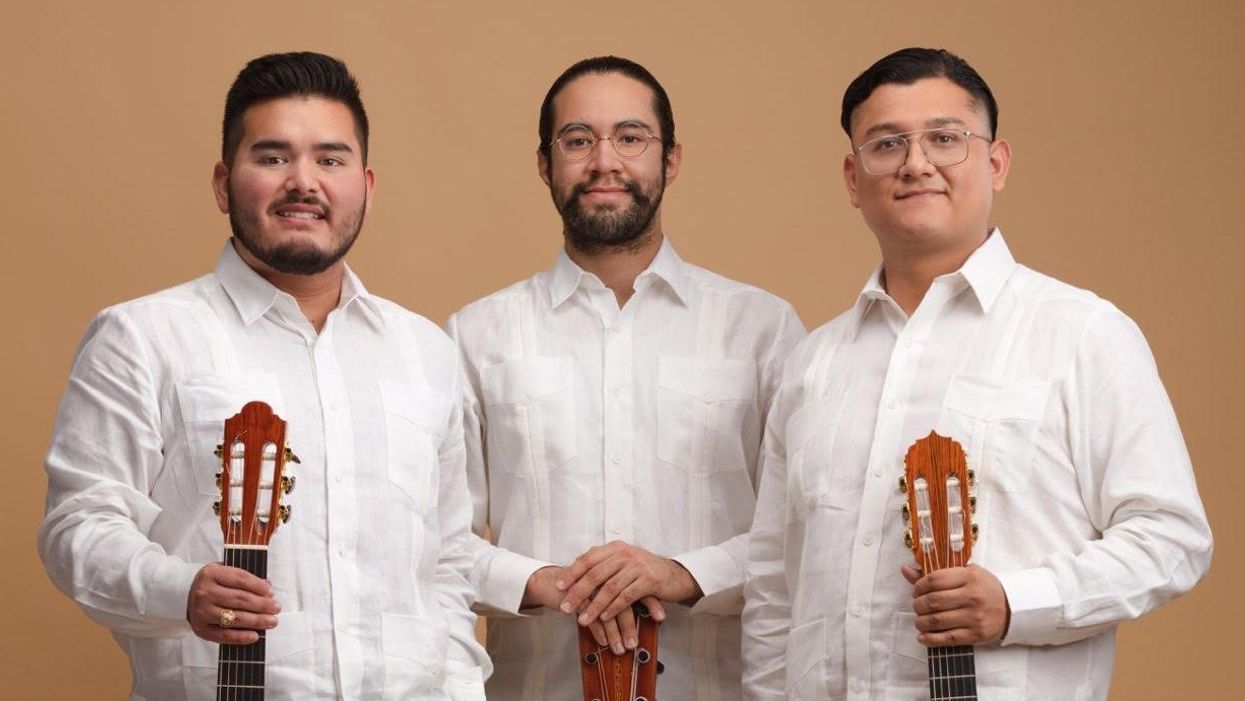
Trio Chapultepec (photo by Ashkan Roayaee)
ON DEC. 8, JAVIER Martínez and librettist Leonard Foglia’s Christmas-themed, mariachi opera El Milagro del Recuerdo (“The Miracle of Remembering”) returns to the Houston Grand Opera.
Since its premiere in 2019, the opera has become a holiday tradition in Houston, and this year’s performances includes several members of the original cast — including mezzo-soprano Cecilia Duarte and the San Antonio-based ensembleTrio Chapultepec, who are onstage for most of the opera, dressed in traje de charro (“cowboy suits”) and sombreros. They anchor Martínez’s score with the traditional mariachi instrumentation of guitar, guitarrón — a large, deep-bodied, six-string bass, and vihuela — a smaller sized, higher tuned five-string guitar.
Trio Chapultepec members Vincent A. Pequeño, Israel Alcala and William Carlton Galvez, along with percussionist Jesús Pacheco, appear on Duarte’s new albumReencuentros, a collection of classic boleros she heard as a child growing up in Chihuahua City. For his part, Pequeño was introduced to mariachi in the eighth grade, by renown musician and educator Gumecindo "Gino" Rivera, with whom he still plays to this day. But at first, Pequeño had no idea what he was getting into.
Trio Chapultepec
San Antonio native Vincent Pequeño joins William Carlton Galvez from Kyle and Israel Alcala from Laredo in Trio Chapultepec. The three gents were selected by...
Trio Chapultepec (photo by Michael Bishop)
“I hadn’t really practiced my Spanish, because my parents didn’t teach me,” says Pequeño, who was born in San Antonio, grew up relatively poor, and initially explored his musical aptitude on a toy piano and “a beat up guitar that only had, like, three strings.” When Rivera asked Pequeño if he’d like to play guitarrón, he immediately said yes. “In my head, I thought he meant the guitar!” says Pequeño, who nevertheless fell in love with the unwieldy instrument and decided to commit himself to a career playing mariachi.
The roots of mariachi date back to the earliest years of the colonial period of Mexico, when a new amalgamation of musical styles emerged across several distinct geographical regions, performed on stringed instruments introduced by the invading Spaniards, and incorporating the rhythms of music by African slaves and indigenous tribes. Over the 19th and 20th centuries, violins and trumpets had been integrated as well. Today, there are mariachi’s throughout Central and South America, as well Japan, Canada, and Dubai.
“It’s not necessarily just music. It’s a culture,” says Pequeño of the genre. “I love folkloric music from Mexico, and mariachi is a kind of culmination of it all into one.” There’s also a sound and feel to mariachi one can only develop by ear and with experience, which for Pequeño meant listening to and getting advice from older mariachi musicians playing along San Antonio’s downtown Riverwalk. “It’s like when someone gives you a recipe,” explains Pequeño. “And you ask, ‘Can I find this online?’ and they tell you, ‘No. It was my grandma’s recipe, and her grandma’s, and her grandma’s … .’”
Pequeño’s mother didn’t tell him how musical his family was until after he’d gotten into music. He then found out she played in band, and that other family members were strongly rooted in San Antonio’s Tejano music scene, but nobody in the family had played mariachi. “My parents love American rock and roll. They never really expected me to choose mariachi,” says Pequeño. “But I just was magnetized toward it, and now I’ve made a whole career out of playing it.”
- Opera Star’s Pop-Tinged New Album Explores a Lost Art from Her Childhood ›
- Post-Harvey and Covid, HGO Reveals a Delightfully ‘Normal’ 2022-2023 Season ›












